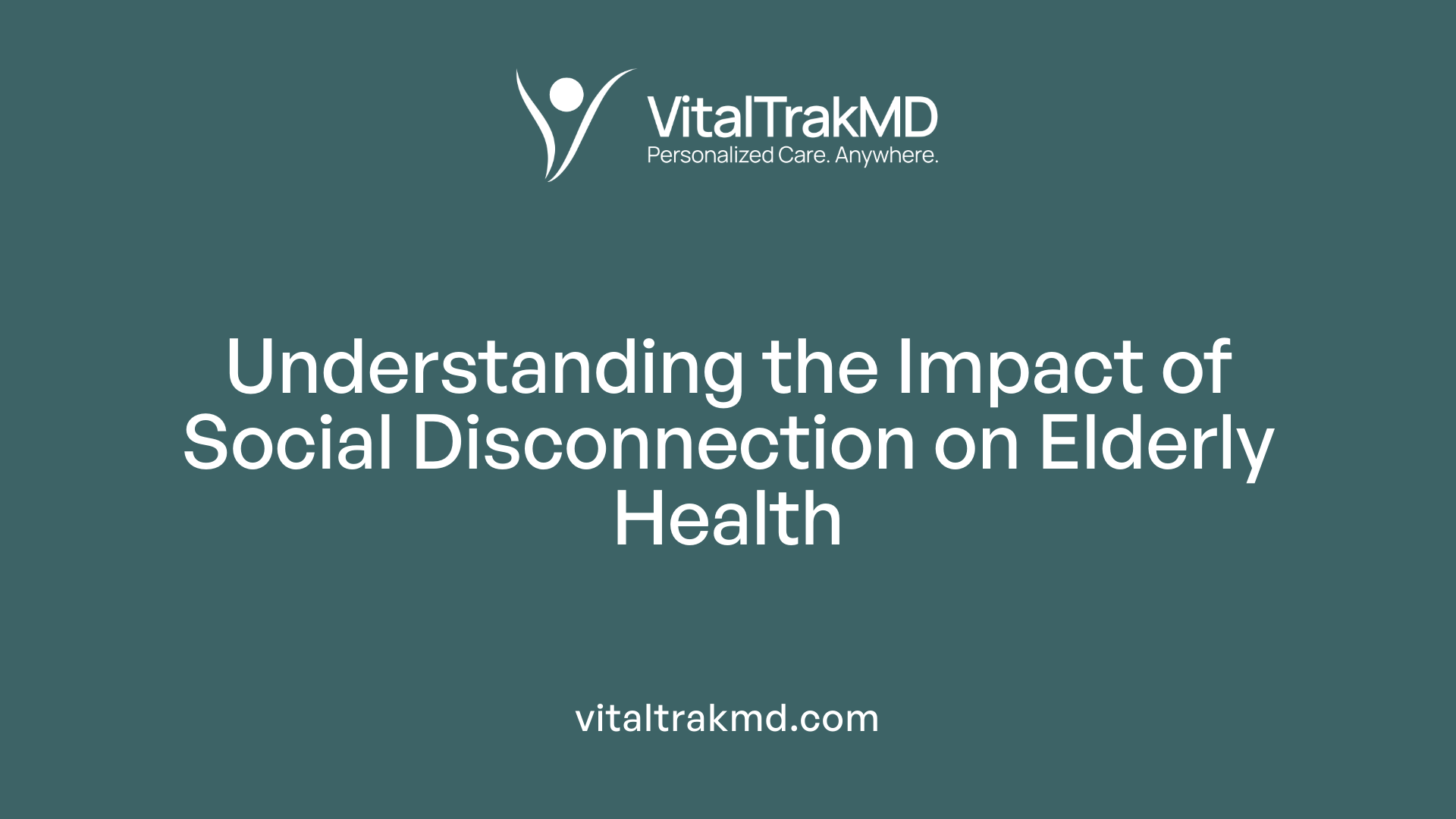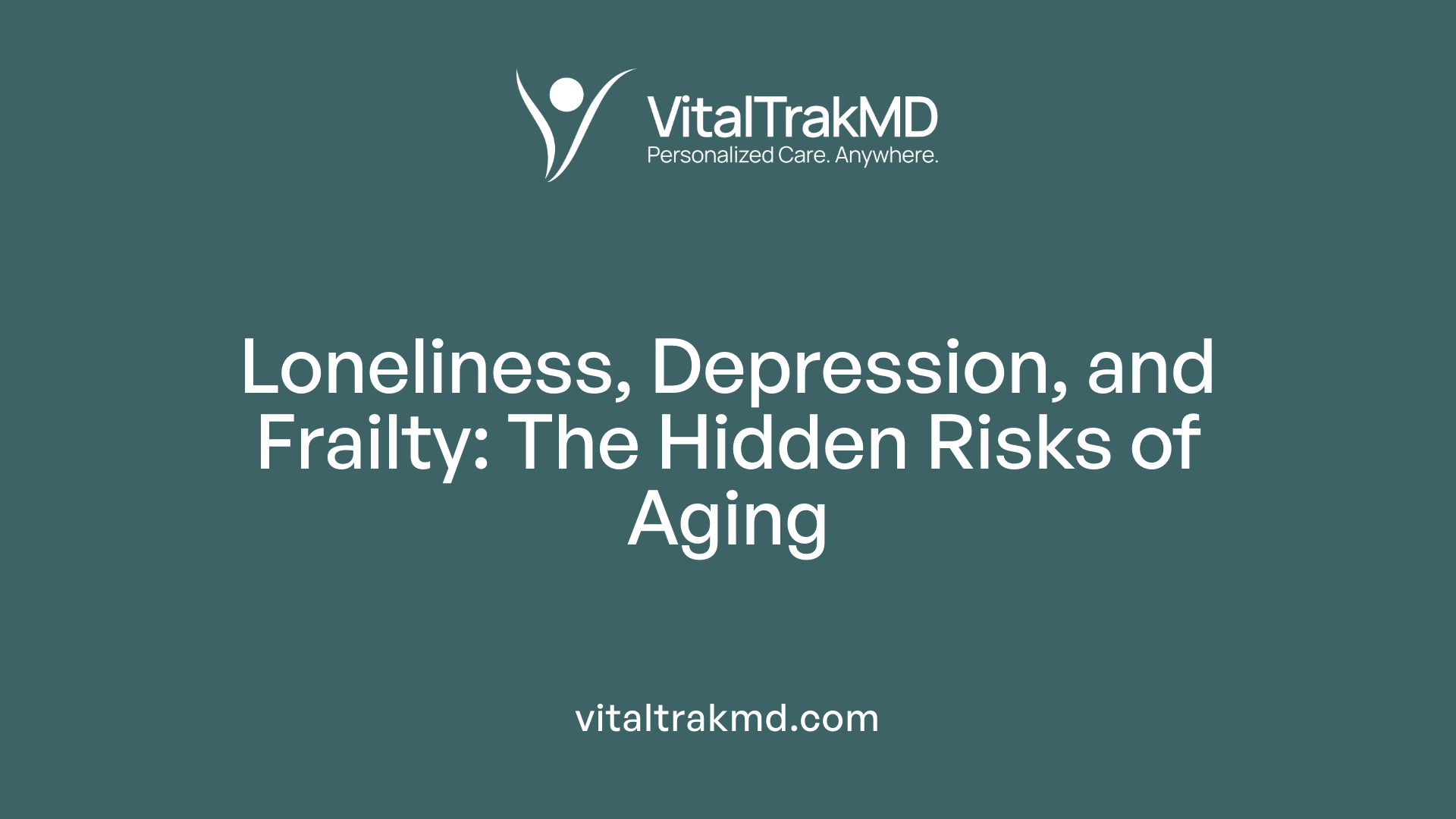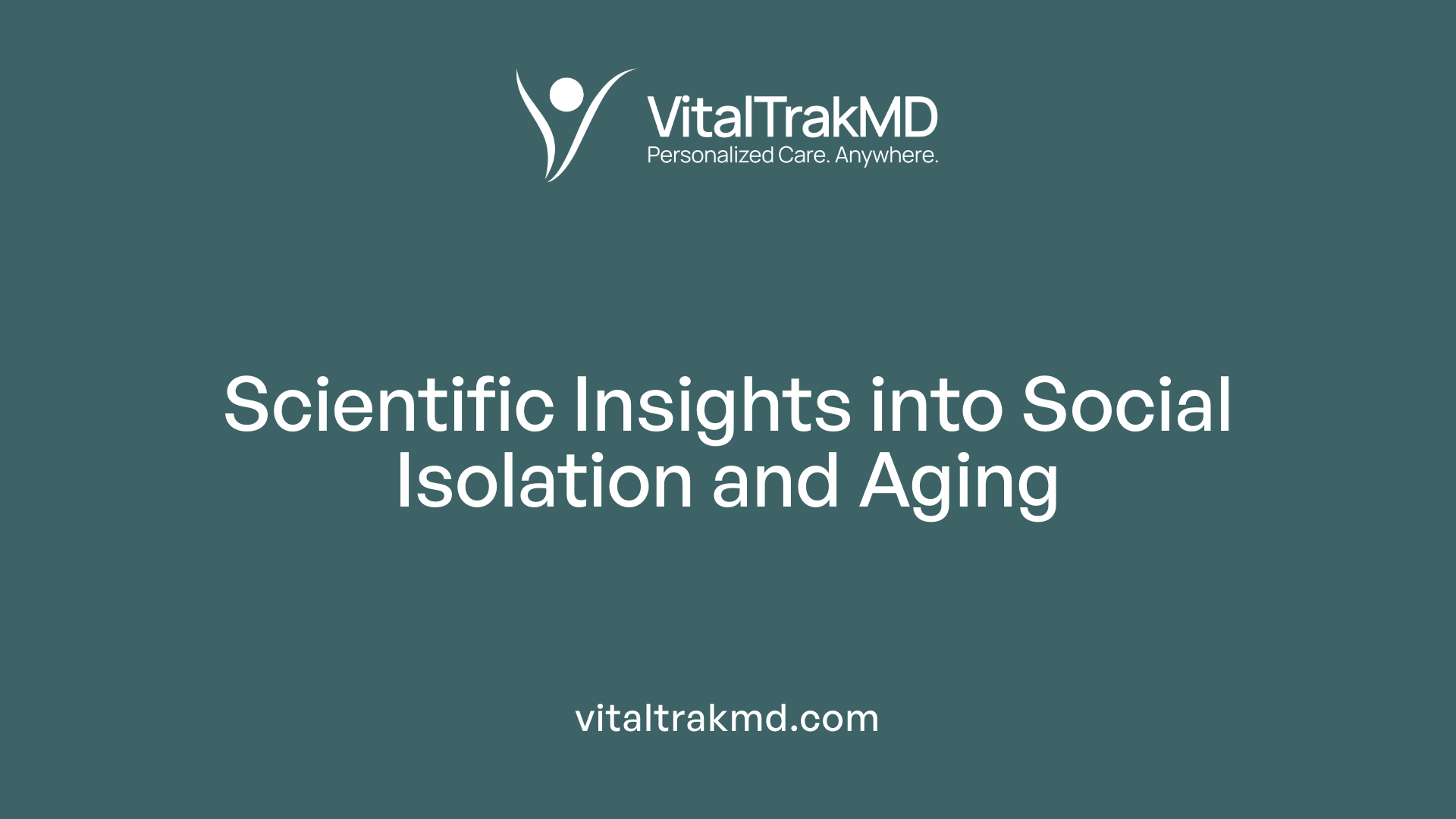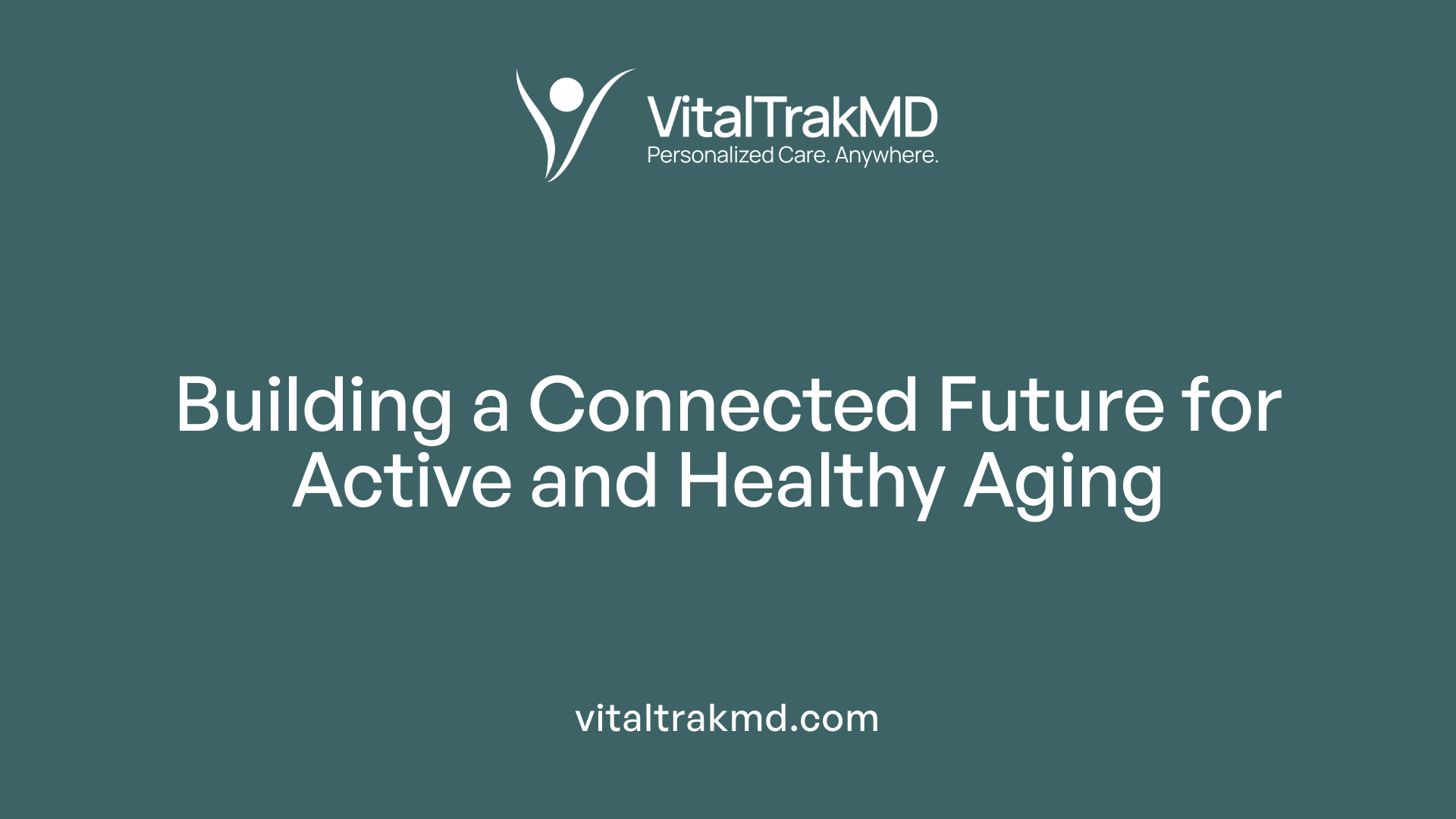The Emotional Impact of Social Isolation on Senior Health and Wellness

Understanding the Vital Role of Social Bonds in Aging Gracefully
As the global population ages, the importance of social connection for seniors’ health and wellness becomes increasingly evident. Social isolation and loneliness are pervasive issues, affecting millions of older adults and leading to serious health consequences. This article explores the multifaceted impact of social disconnection on seniors, highlighting causes, symptoms, risks, and evidence-based strategies to promote meaningful engagement and improve quality of life.
Differentiating Social Isolation and Loneliness in Older Adults
What are the differences between social isolation and loneliness?
Social isolation refers to the objective reality of having few social contacts or limited interaction with others. It is characterized by physical separation or a lack of social relationships, support, or engagement. For example, an older adult living alone with minimal social visits is considered socially isolated.
Loneliness, on the other hand, is a subjective feeling of disconnection or emotional distress caused by a perceived gap between desired and actual social relationships. An individual might have many social contacts yet still feel lonely if those connections lack depth or emotional fulfillment.
While they are related phenomena, social isolation and loneliness are distinct: one is an external condition, and the other is an internal emotional experience. It’s possible for someone to be socially isolated without feeling lonely, and vice versa.
How do social isolation and loneliness independently or jointly impact health?
Both social isolation and loneliness can influence health independently and together, often leading to serious health risks.
Social isolation has been linked to increased rates of physical health issues like cardiovascular disease, hypertension, obesity, and weakened immune responses. It can also lead to reduced physical activity, which increases the risk of falls, muscle weakness, and other health complications.
Loneliness significantly impacts mental health, contributing to depression, anxiety, and cognitive decline. It can accelerate the onset of dementia and impair overall cognitive functioning due to decreased mental stimulation.
When combined, social isolation and loneliness can magnify these risks, elevating the likelihood of premature mortality, stroke, heart disease, and mental health disorders. Both phenomena also trigger biological changes such as increased inflammation, which further contributes to chronic diseases.
Addressing both aspects is crucial. Interventions like community engagement, social support programs, and the use of technology to connect seniors can mitigate health problems related to these social phenomena.
| Aspect | Definition | Impact | Possible Interventions |
|---|---|---|---|
| Social Isolation | Objective lack of contact | Increased physical health risks, mortality | Social activities, transportation, community programs |
| Loneliness | Subjective feeling of disconnection | Mental health issues, cognitive decline | Counseling, social support, mental health services |
| Combined Effect | Both phenomena together | Higher risk of serious illnesses and death | Integrated social support and health management strategies |
Fostering social bonds and reducing feelings of loneliness are essential for improving health outcomes and enhancing the quality of life among older adults.
Health Risks Linked to Social Disconnection in Seniors

What are the effects of social isolation on mental health in seniors?
Social isolation profoundly affects the mental health of older adults. It has been linked to increased risks of depression, anxiety, and suicidal thoughts. Feelings of loneliness and emotional disconnection often result from social separation, amplifying existing mental health conditions or contributing to new ones. These emotional states can lead to social withdrawal, further intensifying loneliness.
Research shows that social isolation can impair cognitive functions, leading to decline in memory, attention, and overall mental acuity. It also disrupts sleep patterns and increases stress levels, creating a cycle that worsens mental health. The biological impact of social disconnection involves increased inflammation, which not only affects mental well-being but also raises the likelihood of physical health problems. Interventions that promote community involvement, support networks, and mental health therapies are vital to counteract these effects and foster better psychological resilience among seniors.
What are the physical, cognitive, and psychological effects of social isolation on older adults?
Social isolation impacts seniors on multiple levels. Physically, it is associated with higher rates of heart disease, stroke, high blood pressure, and obesity. It impairs immune function, making individuals more vulnerable to infections and illnesses, which raises overall mortality risk.
Cognitively, prolonged social disconnection is linked to faster cognitive decline and a significant increase—estimated at around 50%—in the risk of developing dementia. Engaging in social activities has been shown to preserve cognitive skills and delay decline.
Psychologically, loneliness and social withdrawal are closely tied to depression and anxiety. These emotional challenges not only diminish quality of life but can also activate biological pathways promoting inflammation, which further exacerbates health issues. Lifestyle interventions, including community engagement, technology use, and tailored social support, can help address these impacts and promote healthier aging.
| Effects Area | Specific Risks/Consequences | Additional Insights |
|---|---|---|
| Physical Health | Heart disease, stroke, hypertension, obesity | Weakened immune response, increased inflammation |
| Cognitive Function | Faster cognitive decline, dementia risk | Social engagement helps maintain brain activity |
| Mental Health | Depression, anxiety, suicidal ideation | Biological and emotional pathways intricately linked |
| Overall Impact | Increased mortality, reduced quality of life | Interventions can improve health outcomes |
Addressing social isolation through social activities, technology, and community programs is crucial to improving health and quality of life for seniors.
Risks Associated with Loneliness and Frailty in Seniors

What are the risks associated with loneliness, depression, and frailty in the elderly due to social isolation?
Social isolation, loneliness, and frailty in older adults have profound health implications. These conditions are linked to an increased risk of developing serious health issues such as cognitive decline, depression, heart disease, high blood pressure, and obesity.
Lonely and socially isolated seniors often experience a weakening of their immune systems, making them more vulnerable to infections and illnesses. Moreover, these factors contribute to accelerated cognitive deterioration, potentially leading to conditions like Alzheimer’s disease and other forms of dementia.
Biological responses to social disconnection, such as increased inflammation and stress hormone levels, play a role in worsening physical health. Chronic inflammation, in particular, is a common pathway connecting social isolation to cardiovascular diseases and neurodegenerative conditions.
The health risks extend beyond physical consequences. Depression and emotional distress frequently accompany loneliness and can lead to a decline in overall mental well-being. In addition, social isolation correlates with higher rates of hospitalization and longer recovery periods when health issues arise.
Mobility limitations, loss of loved ones, and living alone are significant factors increasing vulnerability among seniors. Without intervention, these factors can escalate, leading to frailty—a state characterized by decreased strength, endurance, and physiological function. Frailty increases the likelihood of falls, disability, and mortality.
Addressing these risks involves promoting social engagement through community activities, leveraging technology for virtual interactions, and providing supportive healthcare services. Interventions that foster meaningful social contacts and purpose can help mitigate these health threats, ultimately improving longevity and quality of life for older adults.
| Risk Type | Associated Conditions | Contributing Factors | Interventions |
|---|---|---|---|
| Physical | Heart disease, stroke, obesity, dementia | Loss of social support, mobility issues, triggers inflammation | Community groups, technology, physical activity |
| Mental | Depression, anxiety, suicidality | Loss of loved ones, loneliness, lack of purpose | Counseling, social programs, mental health support |
| Cognitive | Accelerated cognitive decline, dementia | Social disengagement, brain stimulation deficits | Social activities, cognitive training, social technology |
| Healthcare Use | Increased hospitalizations and longer recovery | Chronic health issues, frailty, social withdrawal | Integrated healthcare, social support, home visits |
Understanding these interconnected risks underscores the importance of comprehensive strategies designed to keep seniors socially connected and engaged, thereby reducing the burden of these health conditions.
Understanding Causes and Symptoms of Social Isolation in Seniors
What causes social isolation among seniors and what are its symptoms?
Social isolation in older adults often results from various physical, emotional, and social factors. Common causes include the loss of loved ones, such as spouses and friends, which reduces their social network and emotional support. Retirement can also lead to decreased social interaction, especially when daily routines and work-related contacts diminish.
Health issues like mobility problems, chronic illnesses, hearing or vision loss, and the inability to drive can significantly restrict seniors' ability to engage socially. Transportation challenges further compound this issue, making it difficult to participate in community activities or visit friends and family.
Decreased participation in social or recreational activities due to physical limitations or loss of interest also contributes to isolation. Additionally, social roles that provided purpose and identity may be lost, increasing feelings of disconnection.
The symptoms of social isolation are both emotional and physical. Emotional signs include feelings of loneliness, sadness, and withdrawal from social interactions. Seniors may show declining interest in hobbies, difficulty concentrating, and mood swings. Physically, social isolation can manifest as fatigue, weakened immune response, and increased vulnerability to health problems.
It is important to distinguish social isolation, which is an objective lack of social contacts, from loneliness, which is a subjective feeling of being alone. An older adult may be socially isolated but not feel lonely if they are comfortable with fewer social interactions. Conversely, a person can have many social contacts but still feel lonely.
Addressing these causes by promoting social engagement, facilitating transportation, and creating opportunities for meaningful activities can notably improve seniors’ health and emotional well-being. Recognizing the symptoms early allows for timely intervention, reducing the risk of further health decline.
Strategies and Interventions to Combat Senior Social Isolation
How can social isolation and loneliness in seniors be addressed through strategies and interventions?
Tackling social isolation and loneliness among older adults involves a variety of approaches tailored to their unique needs and circumstances. Engaging seniors in activities that foster social interaction is essential. Community centers, hobby groups, and cultural events can serve as valuable venues for meaningful social engagement.
Supportive environments also play a crucial role. Creating age-friendly spaces with accessible facilities encourages participation and makes social activities more inviting. Policies that promote social programs, transportation assistance, and accessible venues help remove barriers to social involvement.
Technology offers powerful tools to keep seniors connected. Video calls, social media platforms, and digital communication apps enable older adults, especially those with mobility issues or living alone, to maintain regular contact with family, friends, and caregivers.
Support groups are another effective intervention. Programs that focus on mental health and emotional support, such as peer-led groups or facilitated therapy sessions, help seniors share experiences and build a sense of community.
Structured programs and participatory activities designed specifically for seniors can enhance social interaction and mental resilience. For instance, volunteer opportunities and intergenerational programs promote social bonds across age groups, fostering a broader sense of belonging.
Overall, combining community engagement, technological innovations, and supportive social networks offers a comprehensive strategy to reduce social isolation, improve mental health, and enhance the quality of life for older adults.
Insights from Scientific Research on Social Isolation in Aging

What scientific findings and research insights exist regarding the impact of social isolation on elderly health?
Extensive research in the field of aging has established that social isolation and loneliness are significant factors affecting the health of older adults. Multiple studies have demonstrated that these social phenomena are linked to increased risks of cognitive decline, dementia, depression, and cardiovascular conditions like heart disease and stroke.
Meta-analyses reveal that social isolation and loneliness are associated with about a 50% higher chance of developing dementia. Similarly, there is approximately a 30% increased risk of heart disease or stroke among socially isolated seniors. Furthermore, individuals experiencing social disconnection face a higher overall risk of mortality from various health causes.
Biological mechanisms behind these health impacts include inflammatory responses and behavioral changes. Social disconnection can lead to increased inflammation in the body, which is a well-known contributor to chronic illnesses such as Alzheimer's disease and cardiovascular problems. Additionally, loneliness and social withdrawal often result in poor sleep, physical inactivity, and unhealthy lifestyle habits, further exacerbating health risks.
Pre-pandemic data indicated that roughly one-quarter (24%) of older adults in the United States were considered socially isolated — a figure that has remained steady or increased in recent years, especially among those with declining health or mobility challenges. The COVID-19 pandemic further highlighted these issues, with increased social isolation raising concerns about long-term health consequences.
Interventions aimed at increasing social engagement, such as community participation, caregiving, and counseling, have shown promise. These strategies are vital in reducing health risks and enhancing the emotional and physical well-being of older adults. Continued research efforts are necessary to refine these interventions and deepen understanding of how to best support aging populations vulnerable to social disconnection.
Promoting Awareness and Education About Senior Social Isolation
What educational and awareness initiatives can help mitigate social isolation among seniors?
Raising awareness about the risks associated with social isolation and loneliness is vital for encouraging communities and individuals to take action. Public campaigns, including those run by organizations like the Foundation for Social Connection and the National Alliance for Caregiving, aim to educate the public on how loneliness can impact health.
Healthcare providers can integrate screening tools into routine check-ups to identify seniors at risk of social disconnection. These screenings help to recognize signs such as withdrawal, mood swings, poor appetite, and lack of motivation, ensuring timely intervention.
Community programs offer practical opportunities for social engagement. Senior centers, volunteer initiatives, and support groups facilitate meaningful interactions and foster resilience amongst older adults. These programs can also include training on using technology—such as video calls, social media, and virtual reality—to maintain virtual social ties, especially for those with mobility or transportation challenges.
Educational initiatives should promote the importance of multigenerational friendships, pet companionship, and engaging hobbies that bring joy and foster connection. Teaching seniors about these avenues encourages a sense of purpose and belonging.
By combining public awareness campaigns with targeted healthcare screening and vibrant community activities, society can create an environment where older adults are supported in building and maintaining fulfilling social networks, ultimately reducing health risks associated with social isolation.
The Role of Technology in Fostering Social Engagement Among Seniors
 Technology plays an increasingly vital role in helping older adults stay socially connected, especially when used alongside traditional in-person interactions. Digital tools such as social media platforms, video calling applications like Zoom or FaceTime, and virtual reality platforms offer seniors new avenues for social engagement.
Technology plays an increasingly vital role in helping older adults stay socially connected, especially when used alongside traditional in-person interactions. Digital tools such as social media platforms, video calling applications like Zoom or FaceTime, and virtual reality platforms offer seniors new avenues for social engagement.
By leveraging these technologies, seniors can maintain regular communication with family, friends, and community groups regardless of physical or geographic barriers. For example, a family living apart can host weekly video chats, or seniors can join virtual community events and support groups, reducing feelings of loneliness and social isolation.
Training and supporting seniors in digital literacy is crucial. Many older adults may face challenges in learning new technologies, so providing user-friendly instructions and ongoing assistance can empower them to participate fully. This approach enhances their confidence in using digital platforms and encourages active social participation.
When combined with in-person activities, such as visits to community centers or participation in senior programs, digital methods create a comprehensive support system. This blended strategy addresses different needs and abilities, fostering a sense of belonging and emotional support.
In sum, advances in technology enable meaningful social interactions and provide vital tools for maintaining mental and emotional health in older populations. Proper implementation and training ensure that seniors can reap the full benefits of these innovations, ultimately reducing social isolation and enhancing their quality of life.
Legal and Policy Measures to Support Social Connectivity for Seniors
What policies can help enhance social connection among older adults?
Creating supportive environments for older adults requires thoughtful policy initiatives that foster social engagement and reduce isolation. Policies promoting age-friendly communities play a vital role, ensuring that neighborhoods are accessible, safe, and welcoming for seniors. These include enhancements in public transportation, making it easier for older adults to access social activities, healthcare, and essential services.
Anti-discrimination laws are equally important, protecting seniors from ageism and ensuring equal opportunities in employment, housing, and community participation. Such legislation reinforces the dignity and social inclusion of older adults.
Community centers and programs tailored specifically for seniors are supported through public funding, enabling activities that promote social interaction, mental stimulation, and physical health. These initiatives often include intergenerational exchanges, volunteering opportunities, and support groups, fostering a sense of purpose and belonging.
Housing policies that encourage models like co-housing and supportive living arrangements can facilitate daily social contact and provide emotional support networks. Furthermore, laws that promote or facilitate digital connectivity—such as grants for internet access and digital literacy programs—help bridge the gap caused by mobility or health limitations.
Legal measures also include safeguarding seniors from abuse and neglect through strict regulations, mandatory reporting requirements, and resource allocations for protective services. These protections are essential for mental and emotional well-being.
In summary, comprehensive policies that integrate transportation support, anti-discrimination laws, community development, digital inclusion, and safety measures are fundamental. They enable older adults to remain active, engaged, and socially connected, which is crucial for maintaining their health, independence, and quality of life.
| Policy Focus Area | Specific Initiatives | Expected Impact |
|---|---|---|
| Age-Friendly Communities | Improved walkability, accessible public spaces | Increased outdoor activity, social interactions |
| Anti-Discrimination Laws | Protection from ageist practices | Enhanced dignity, increased opportunities for engagement |
| Transportation Support | Subsidized transit, shuttle services | Greater mobility, easier access to social venues |
| Digital Inclusion | Internet subsidies, digital literacy education | Better virtual connections, reduced isolation |
| Community and Housing Policies | Support for senior-friendly housing options | Enhanced daily contact, emotional support |
| Safety and Abuse Protections | Clear laws, protection programs | Greater peace of mind, mental health stability |
This integrated policy approach can significantly diminish social isolation and promote healthier, more connected lives for older adults, leveraging community resources, legal protections, and technological advancements.
Creating Supportive Environments for Active Aging
How can environments be designed to foster social connection and active aging?
Developing spaces and systems that encourage older adults to stay active and socially engaged is essential for healthy aging. Age-friendly environments are designed with accessibility, safety, and social interaction in mind.
Public spaces such as parks and community centers play a crucial role. These should be equipped with comfortable seating, walking paths, and designated social zones where seniors can meet and interact easily. Such facilities promote physical activity and provide natural opportunities for socialization.
Housing options are also important. Cohousing communities and assisted living facilities that prioritize communal spaces and activities support ongoing social engagement. These settings can help prevent feelings of loneliness and social isolation.
Transportation is another critical aspect. Easy and reliable access to public transport or community shuttles ensures seniors can travel independently to social activities, healthcare, and errands.
Community resources like libraries, faith groups, and volunteer organizations further strengthen social bonds. Supporting activities such as classes, hobby groups, and volunteer programs help older adults build meaningful connections.
Creating a safe, inclusive, and stimulating environment can significantly improve the mental and physical health of seniors. When communities are designed to facilitate active participation and social support, they foster a sense of belonging and purpose among older residents.
For more insights on building such communities, searching for "designing age-friendly communities for seniors" can provide additional strategies and success stories.
Conclusion: Enhancing the Future of Aging with Social Bonds

Why is social connection important for the overall well-being of seniors?
Social connection plays a crucial role in the health and happiness of older adults. It is linked to better physical health, longer lifespans, and improved mental well-being. When seniors maintain strong relationships, their risk of depression, anxiety, and chronic diseases such as heart disease, stroke, and dementia decreases.
Moreover, social engagement encourages mental stimulation, which helps preserve cognitive functions like memory and attention. Participating in community activities, hobbies, or volunteering not only provides emotional support but also promotes healthier lifestyle habits such as better nutrition and sleep.
Conversely, social isolation, which involves a lack of social contacts and relationships, can be as damaging as smoking or obesity. It increases health risks and accelerates cognitive decline. Tackling barriers like hearing impairment, transportation problems, and mobility limitations is vital to fostering social bonds.
Overall, fostering social connections supports healthier aging, improves quality of life, and has the potential to extend longevity among seniors.
Fostering a Connected Future for Our Seniors
The evidence underscores that social connection is fundamental to the health and happiness of older adults. By understanding the profound impact of social disconnection, communities, policymakers, caregivers, and healthcare providers can develop targeted strategies to reduce isolation and foster meaningful relationships. Implementing technological solutions, creating age-friendly environments, and promoting inclusive policies are essential steps toward supporting healthy aging. As we look to the future, fostering a culture of connection and compassion will be vital for ensuring that seniors enjoy not only longer lives but vibrant, fulfilling ones. Every effort invested in strengthening social bonds today can significantly enhance the well-being and resilience of our aging population tomorrow.
References
- Social isolation, loneliness in older people pose health risks
- Health Effects of Social Isolation and Loneliness - CDC
- The Impact of Social Isolation on Senior Health and How to Combat It
- Mental health of older adults - World Health Organization (WHO)
- Analyzing the Impact of Social Isolation on Aging: Health, Mental ...
- [PDF] Our Epidemic of Loneliness and Isolation - HHS.gov
- Health effects of loneliness and social isolation in older adults living ...
Recent articles
Want to Feel Better and Live Healthier?
Join hundreds of patients taking control of their health with personalized care that fits their life – not the other way around.
Rated 4.8/5 by 32+ customers







